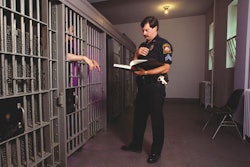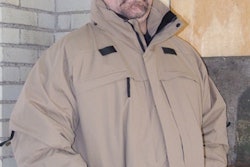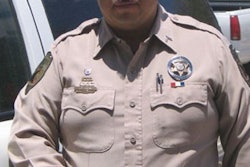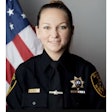Recently, Officer Nick Erfle of the Phoenix Police Department was killed in the line of duty. Erfle, a 33-year-old family man, was shot by an illegal alien when he stopped the man for jaywalking.
The murder of Officer Erfle clearly demonstrates that stopping someone for even the most minimal offense can put a cop in serious danger. In this particular case, once a police record check confirmed that the man was wanted, he reacted by drawing a concealed handgun and shooting Officer Erfle in the face. The cop killer/illegal alien then made his escape by carjacking a vehicle but was later shot and killed by a Phoenix officer.
Unfortunately, Officer Erfle will not be the last law enforcement officer who will fall victim to a bad guy carrying a concealed firearm. The reason is simple; unless you have cause to search, you really can't tell who is packing and who isn't.
Hard to Tell
Outside of the obvious suspicious bulge, or an actual gun butt protruding from someone's clothing, it is virtually impossible to know if an individual is carrying a concealed firearm. One way to deal with this ongoing problem is to assume that every subject or individual that you meet or encounter is armed until you prove otherwise.
That means that the best way to survive an encounter with an illegally armed individual is to exert complete control over everyone you stop, everyone you confront for any reason, and everyone you meet until you can confirm that they are not a threat to you. You must also adopt the mindset that human beings are clever enough to try anything that works when it comes to concealing firearms, other weapons, and contraband on their persons or in their vehicles.
Don't believe me? Consider this: How many years have you been carrying a legally concealed handgun? How many times have you been stopped by fellow officers because someone spotted your gun and notified the authorities that you were armed? You may look like a cop and that may put people at ease when they see your gun or you may have to look like a stereotypical violator because of your assignment. Either way, I would bet that most of you have never been confronted by a fellow officer because you were carrying.
In all my years of legally carrying concealed firearms—even when I worked undercover looking like a drug dealer with a beard, a long pony tail, and a $10,000 gold Presidential Rolex watch—I was never stopped by another law enforcement officer for anything other than speeding.
During the last UC operation that I worked, I purchased two fully automatic AK-47 assault rifles and 4,000 rounds of ammunition in a strip mall parking lot in broad daylight. Unbeknownst to me at the time, our backup team had lost sight of me and my female partner during the transaction. This meant that we were on our own while we made the buy then drove from a border town to a nearby major U.S. city.
The point of this story is as follows: Even though I looked like a pirate, I drove for more than an hour with AK-47s and Chinese ammunition in the trunk of a fire engine red Mustang and never saw one cop, including the agents who were supposed to be protecting us.
Write this in bold block letters somewhere across your mind: You cannot assume that someone is unarmed. Even bad guys who don't put in any effort or thought into concealing their guns are rarely taken down just because they are carrying illegally. Those who do put some time and effort into concealing their guns are almost never busted just for carrying illegally.
Taking Control
Your job is to ensure that you always remain in a position to exert complete control at all times. In order to accomplish this you must inform all subjects involved in any stop or enforcement action that they must not move, they must keep their hands where you can see them, and they must not place their hands inside their clothing or inside any compartments for any reason unless you instruct them to do so.
It also makes sense to ask everyone you stop or challenge to tell you if they are armed with any firearms or weapons. Naturally, you should use a tone of voice befitting the circumstances at hand whenever you inform citizens of the rules of engagement and you ask if they are armed.
Above all, listen to your instincts and be prepared to react when you perceive danger. Remember, outside of getting ambushed, cops get killed and get injured when they lose control.
Legally Armed
Law-abiding Americans have a right to own firearms. Some even have a right to carry concealed firearms. That can lead to potentially disastrous confrontations with police officers when a gun owner does something that makes you think he or she is a threat.
Consider this example from my career. While looking for smugglers on Key Biscayne one night, I identified myself and asked a male passenger in a car that was stopped near a boat ramp if there were any firearms in their vehicle. Instead of saying, "Yes, officer," and telling me where his pistol was located, the passenger said absolutely nothing as he leaned forward very quickly, enough to startle me, and opened the glove compartment of the car.
All hell broke lose. I raised my service pistol with my right hand and yelled something like, "U.S. Customs! Don't move…! Don't move!" Adding to the chaos, my partner yelled commands at the woman behind the steering wheel who was, of course, screaming at her boyfriend. Seconds passed like hours, as I prepared to shoot.
Fortunately, the young male passenger froze just as he started to reach inside the glove compartment. I reached in and recovered a Walther PP from the glove compartment, and disassembled it on the hood of the car. Once we cleared the couple of any wrongdoing, my partner and I left the area after learning a very important lesson.
Not everybody who owns a gun is a dirtbag. Some law abiding people simply don't realize that their actions can appear threatening to the police. In other words, they don't connect the dots. If I do A, the police officer will do B.
Inventive Concealment Methods
Yes, good people have concealed guns. But make no mistake about it, so do bad people, and they are very talented at hiding their weapons.
Over the years, illegally armed individuals have used a variety of methods to transport and conceal firearms. Criminals have hidden guns in their crotches, in special pockets in their baggy jeans, in concealed compartments inside their pants, in their waistband, and the same way that you do in ankle holsters, shoulder holsters, belt holsters, and fanny packs. They have also had less suspicious looking members of their entourage carry a gun for them.
One of the most interesting methods of concealed carry that I have ever heard about was explained to me by a New York City officer who arrested a man with a special concealment rig.
This guy used a wire hanger to suspend a compact pistol inside the crotch of his baggy pants. According to the NYPD officer, the wire hanger was shaped like the letter "S." One end was stuck inside the barrel of the pistol, which was suspended inside the bad guy's baggy pants. The other end of the S-shaped wire hangar was hung over the waistband.
This particular 20-year veteran of the NYPD also says that, in his city, perps now like to keep their handguns concealed in their vehicles right up until the time they need to use them. This is done because stepped up enforcement has made it difficult for illegally armed individuals to walk the streets or go from one club to another without being approached by police officers and "tossed" or searched for weapons.
Tricked Out Cars
Vehicles must be included in this conversation because cars, vans, pickup trucks, and SUVs are routinely used to transport contraband and concealed firearms. As many of you already know, many criminals also have their vehicles modified to create easily accessible but hard to detect hiding places for their weapons.
One such modification is to remove the airbag on the steering wheel or in the dashboard to create a false compartment that can be used to conceal a handgun.
Other locations inside the cabin area are also used to hide guns and contraband in motor vehicles. Some armed violators even have switches installed in their cars that can be used to release the locking mechanism on a secret compartment. For example, the NYPD officer that I talked to once found a .25 caliber pistol inside a secret compartment that was located in the center console of an SUV.
Spotting the Gun
OK, we've discussed how hard it really is to detect a concealed weapon just from visual clues. We've also discussed that your best defense is to control the situation and never assume that someone is unarmed. And we've discussed where bad guys like to hide their weapons. Now, let's talk about a visual method for spotting a concealed gun.
My favorite method of detection involves a variation of the technique that was drilled into my head by my flight instructor when I learned how to fly a plane. He told me to quickly scan the gauges and scan the sky outside the cockpit. You can use a modified version of this technique to protect yourself while you determine whether or not a suspicious person is illegally carrying firearms.
Constantly evaluate all eye contact, actions, mannerisms, and tones of voice. And monitor the way the subjects communicate and interact with each other, while you constantly scan the hands of the person or persons you are interviewing or challenging.
Remember, quickly scan a subject's eyes and hands then scan the area around you, especially if you are working alone or with a partner who is inexperienced. Repeat this process until you complete the stop or field interview.
A quick note: Be careful when using this technique at night with a flashlight. Don't shine your flashlight on anything that will reflect the beam back in your face and damage your night vision. If anything, you should use your flashlight to damage a subject's/suspect's night vision.
Naturally, if a subject defies your instructions and moves or attempts to retrieve a weapon from a pocket or under his or her clothing you must take the appropriate action to protect yourself and other law abiding citizens. If you are forced to pull the trigger to stop a threat from continuing to be a threat, your actions will be judged by how you adhere to the law and department policy.
Yes, you can detect a concealed weapon with just a visual scan. But it's more likely that you will spot signs that a person has a weapon in his or her eyes or body language.
A veteran Tucson officer who was interviewed for this article stressed the importance of evaluating eye contact whenever you approach anyone who may be armed.
According to this now retired police officer, illegally armed individuals tend to give themselves away by trying to appear casual as they adjust their clothing to make sure their weapon is not protruding against their clothes.
Evaluating body language can also be an extremely effective tool to use when you examine a potential suspect from a distance before you move in to conduct a field interview or stop.
Just remember that you can't assume that even a jaywalker is unarmed. So as you approach a subject, suspect, or violator you must be prepared to go tactical at a moment's notice.
Special thanks to Doug Mackinlay, CEO of Diamondback Police Supply (www.diamondbackpolice.net), for allowing the author to use his facility and members of his sales staff in the photographs for this article.
Nick Jacobellis is a medically retired U.S. Customs agent and former police officer who was physically disabled in the line of duty while working undercover. He is a frequent contributor to POLICE.














